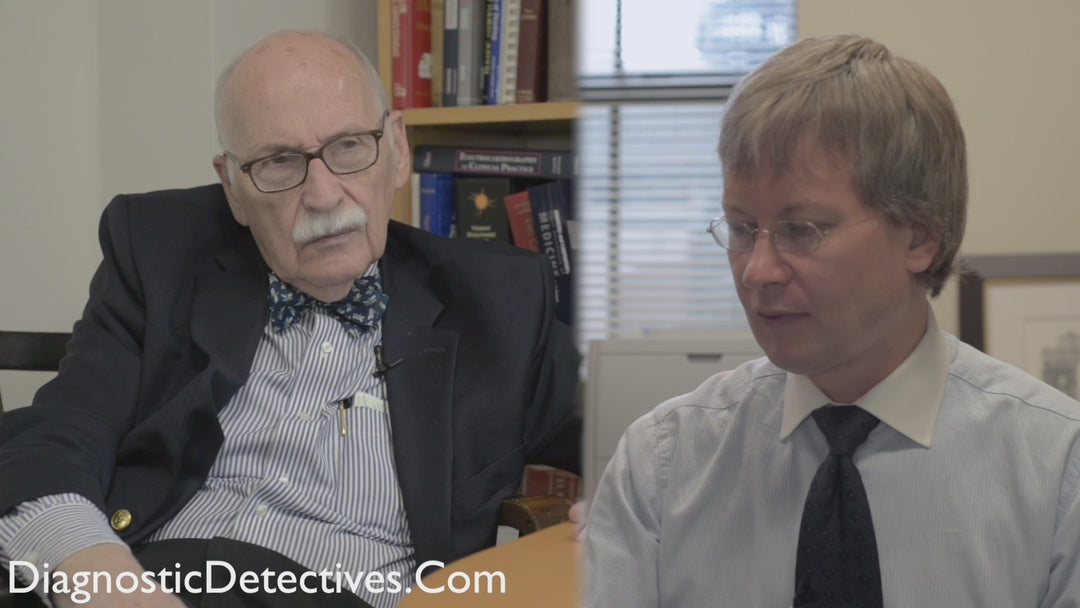Dr. Marshall Wolf, MD, en førende ekspert inden for klinisk medicin og medicinsk uddannelse, belyser lægens afgørende rolle i det moderne sundhedsvæsen. Han fremhæver, at den kliniske metode står over teknologien. Dr. Wolf beskriver en trinvis diagnostisk proces, der tager sin begyndelse i menneskelig kontakt. Han argumenterer for en afbalanceret tilgang, hvor teknologi understøtter den kliniske vurdering frem for at erstatte den. Denne fremgangsmåde sikrer præcise diagnoser og opretholder en medfølende tilgang til patientbehandling.
Den Kliniske Metode: En Menneskecentreret Tilgang til Moderne Medicinsk Diagnostik
Spring til afsnit
- Det Menneskelige Element i Medicin
- Den Kliniske Metode Forklaret
- Teknologis Rigtige Rolle i Diagnostik
- Almindelige Diagnostiske Fejl at Undgå
- Et Praktisk Diagnostisk Eksempel
- Fuld Transskription
Det Menneskelige Element i Medicin
Dr. Marshall Wolf, MD, starter med at understrege den centrale menneskelige dimension i patientomsorg. Han påpeger, at patienter ofte kommer til lægen bange eller i benægtelse omkring deres helbred. Lægens første opgave er at erkende og imødekomme denne følelsesmæssige tilstand. Denne menneskelige kontakt danner grundlaget for hele den diagnostiske og behandlingsmæssige proces.
Den Kliniske Metode Forklaret
Dr. Marshall Wolf, MD, præsenterer Den Kliniske Metode som hjørnestenen i effektiv medicinsk praksis. Denne systematiske proces starter med patientens primære klage og sygehistorie. Lægen udformer derefter flere diagnostiske hypoteser baseret på den indledende information. En målrettet fysisk undersøgelse følger, som hjælper med at afklare de mulige diagnoser. Metoden prioriterer kritisk tænkning og klinisk skarpsindighed før teknologien kommer i spil.
Teknologis Rigtige Rolle i Diagnostik
Dr. Marshall Wolf, MD, præciserer, at teknologi ikke er fjenden i god medicinsk praksis, men et kraftfuldt værktøj. Han fremhæver, at teknologi leverer løsninger, der var utænkelige for årtier siden. Dens korrekte anvendelse kommer efter, at Den Kliniske Metode har indsnævret de mulige diagnoser. Teknologi bør bruges til at be- eller afkræfte specifikke diagnoser, som er identificeret gennem anamnese og fysisk undersøgelse. Dette sikrer, at prøver er målrettede, effektive og medicinsk begrundede.
Almindelige Diagnostiske Fejl at Undgå
En afgørende fejl, som mange læger begår, er at vende den rigtige diagnostiske rækkefølge om. Dr. Wolf bemærker, at nogle klinikere går direkte fra en primær klage til at anmode om avancerede prøver. Denne teknologi-først-tilgang er forkert på den og kan føre til fejldiagnoser og unødvendige indgreb. Den springer over de essentielle trin med hypotese-dannelse og klinisk undersøgelse. Dr. Anton Titov, MD, og Dr. Marshall Wolf, MD, er enige om, at tænkning altid skal komme før apparaterne.
Et Praktisk Diagnostisk Eksempel
Dr. Marshall Wolf, MD, giver et konkret eksempel for at illustrere sin pointe. Når en patient kommer med brystsmerter, kan differentialdiagnosen omfatte lungebetændelse eller brystvægssmerter. En fysisk undersøgelse kan ofte skelne mellem disse tilstande uden billeddiagnostik. Hvis der stadig er usikkerhed, kan et simpelt røntgenbillede af brystkassen være det næste logiske skridt. Dette står i skarp kontrast til at bestille avanceret scanning som CT eller MR med det samme, hvilket ofte er unødvendigt.
Fuld Transskription
Dr. Anton Titov, MD: Et af målene med dette projekt er at fremhæve primatet og værdien af mennesket i medicinen. Vores mål er at levere en modvægt til den voksende opfattelse, at læger er blevet teknologiens tjenere og ikke meget andet.
Hvordan ser du lægens rolle i den nuværende teknologi-drevne verden? Hvordan fremmer man værdien af menneskelighed og medfølelse i moderne medicin? Hvordan får man offentligheden til at forstå denne værdi?
Dr. Marshall Wolf, MD: Du berører to emner. Det ene handler om det menneskelige aspekt. Det er vigtigt at være opmærksom på, hvad patienten gennemgår følelsesmæssigt, når man håndterer dem.
Faktum er, at de kan være bange. De kan have en stor portion benægtelse i forhold til deres problem.
Det andet emne er balancen mellem gammeldags klinisk medicin og ny teknologi. Jeg ser dem ikke som konkurrerende. Jeg har været med i lang tid. Jeg har set ny videnskab og teknologi give patienter noget, som jeg ikke kunne have leveret, da jeg startede i faget.
Jeg har set teknologi hjælpe med at helbrede eller støtte patienter. Det vigtige er dette: lægens første opgave, når en patient kommer ind, er at vurdere, "Er patienten syg eller ej?"
Nogle gange er patienter bekymrede over noget, der ikke er alvorligt. Det er ikke en sundhedsfare. Det skal man vurdere.
Derefter, når man har vurderet, at de har et problem, skal man bruge anamnesen til at finde ud af, hvad der muligvis foregår. Jeg taler gerne om Den Kliniske Metode.
Patienten kommer ind med en klage. Man lytter til deres historie. Man har derefter flere hypoteser om, hvad der kunne være tale om.
Man taler yderligere med patienten for at præcisere hypoteserne. Baseret på dem foretager man en fokuseret fysisk undersøgelse. Det kan ændre på hypoteserne.
Derefter, baseret på anamnese og fysisk undersøgelse, siger man, "Jeg er bekymret for A, B og C." På det tidspunkt inddrages teknologi for at afgøre, "Er det A, B eller C?"
Problemet er, at mange læger starter forkert. Patientens primære klage gives, og læger går straks i gang med avancerede prøver.
Det er den forkerte fremgangsmåde. Det er bagvendt. Det er tænkning først, derefter apparater.
Ja, man forsøger måske at finde ud af, om patienten har lungebetændelse eller brystvægssmerter. Et røntgenbillede kan være nyttigt, hvis en fysisk undersøgelse ikke afklarer spørgsmålet. For det problem har man som regel ikke brug for CT eller MR.
Ofte kan man ved en fysisk undersøgelse afgøre, om de har lungebetændelse, uden et røntgenbillede af brystkassen.





